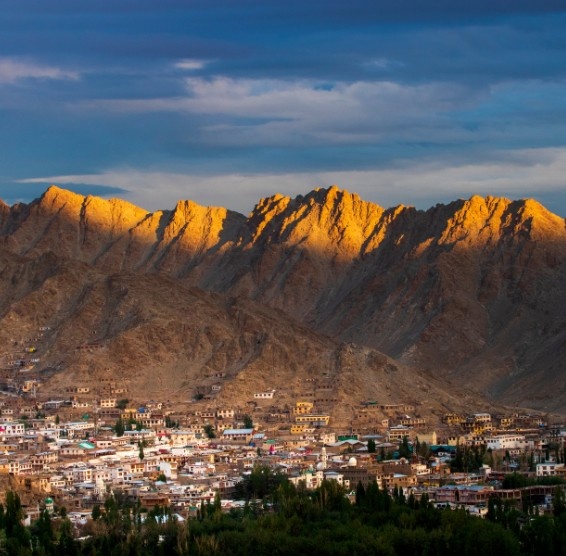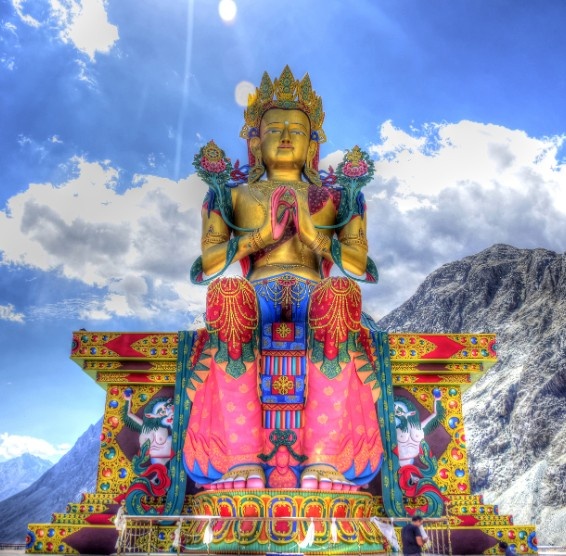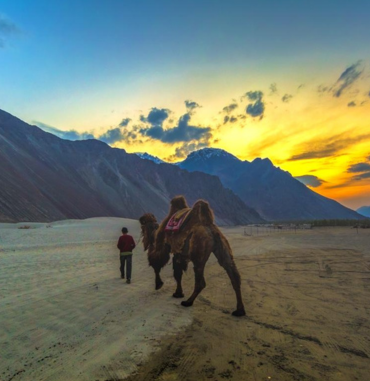Leh–Ladakh: Journey to the Land of High Passes
Explore stunning landscapes, peaceful monasteries, and the thrill of the open road

Leh–Ladakh – The Soul of the High Himalayas
Leh-Ladakh is a magical place high up in the mountains that every adventurer wants to see. Imagine the thrill of breathing the thin, crisp air above craggy, sun-baked mountains with endless blue skies above them. Below, the Indus Valley is quiet. This "Little Tibet" in India is beautiful and the people there are very friendly. Leh-Ladakh is a paradise in the summer, with clear skies, starry nights, and a lively mountain culture. Leh-Ladakh feels like stepping into a travel fairytale, whether you're a road-tripper who's driven up the Leh–Manali Highway, a rider who's braved passes like Rohtang and Khardung La, or a backpacker who's hiked from monastery to monastery.
Location & Geography of Ladakh - Leh-Ladakh is in the far north of India and is now part of the union territory of Ladakh. The Great Himalaya range is to the south, and the Karakoram–Kunlun range is to the north. The majority of this area is higher than 3,000 to 4,000 meters. "Ladakh is the highest plateau in India, and most of it is over 3,000 m high." A lot of it is dry high desert because the Himalayas block the monsoon clouds, so it doesn't rain much. The Indus River and its tributaries are Ladakh's lifelines. They get their water from snow that falls on the peaks in the winter. You’ll often see terraces of fields near villages, thanks to carefully diverted meltwater, amidst vast barren mountain vistas.
Leh-Ladakh is one of the least crowded areas in India. People in the valley towns and villages speak Ladakhi and Balti, which are Indo-Aryan and Tibetan languages. Leh city, which is about 3,500 meters above sea level, was the summer capital of the old kingdom. Kargil, which is to the west, is now Ladakh's other district. Most people in Leh are Tibetan Buddhists, while most people in Kargil are Shia Muslims. This shows how Ladakh is a unique frontier culture. People live in groups of mud houses with flat roofs, and prayer flags fly in the mountain winds.
Juniper forests peek out from behind poplar forests near the Indus River in the Leh Valley (above). There are sharp brown ridges and snow-capped peaks in every direction. The height of this distant land shapes it. Roads twist over passes like Chang La (5,360 m) and Khardung La (5,359 m), and the air gets thinner quickly. Knowing the geography helps explain everything about traveling to Leh-Ladakh, like how remote it is, why you plan acclimatization days, and why the scenery looks so strange other worldly. There are also incredible views around every corner, like the deep canyons, high lakes, and peaceful gompas.
Best Time to Visit Leh Ladakh
- There are good reasons why the summer months (June to September) are the best time to visit Leh-Ladakh. During these warm months, mountain passes are open, roads are mostly snow-free, and the weather is dry and sunny. During the day, temperatures in Leh can reach 20–25°C. At night, it stays cool but not too cold. You can even call Ladakh a "paradise" now, with clear skies that are great for camping, hiking, and stargazing. You can get to all the main attractions, like Pangong Lake, Nubra Valley, and Hemis Monastery. In the summer, there are also festivals like the Ladakh Festival (Leh) and Hemis Tsechu.
- If you fly in early in late spring (May), it might work, but some high passes might still be closed. Leh gets its first snowfalls in October, and tourist services start to slow down. Winter (November to February) is very cold (below freezing at night), and most roads close when it snows. But some hardcore travelers still come to see the winter scenery or celebrate Losar, the Ladakhi New Year, in December or January.
- No matter what time of year it is, get ready. The sun is strong in the summer at high altitudes, so you need to wear uv 50+ SPF sunscreen, sunglasses that block UV rays, and layers of clothing. We locals say that you should always have a warm windbreaker with you, even in July, because the weather in the mountains can change quickly. And note: because Leh itself is at ~3,500 m, acclimatization is vital no matter when you come. When you get to Leh, plan on taking one or two days off to drink a lot of water and get used to the change (no alcohol). This way, you'll be ready to safely hit the trails and passes.
Top Tourist Destinations
- Pangong Lake (Pangong Tso):This well-known brackish lake is about 5,000 meters high. The deepest parts of it are a beautiful mix of turquoise and deep blue that changes with the light. Most of the lakebed is in India, and the eastern shores are in Tibet. Camp on the north bank of Pangong (where the movie "3 Idiots" was filmed) for sunsets and nights under the Milky Way. Looking at the stars here is like magic.
- Nubra Valley:Nubra is a high-altitude cold desert valley that is known for its sand dunes and Bactrian (two-humped) camels. You can get there through the world's (in)famous Khardung La pass. It is a one-of-a-kind experience to ride one of these shaggy camels over the white sand dunes at Hunder. You should also go to Diskit Monastery, which has a huge Buddha statue that looks out over the valley. The willows and poplar trees here stand out against the bare slopes all around.
- Hemis and Thiksey Monasteries:The gompas in Ladakh show off the area's Buddhist history. The largest and most well-known monastery is Hemis Monastery, which is 45 km from Leh. The colorful ceremonies of the masked Cham dance festival draw visitors every July. Thiksey Monastery (see picture below) is on top of a hill near the Indus River. It is famous for its 49-foot Maitreya Buddha statue and its views of the valley below. The sound of monks chanting morning prayers is something you won't forget.
- Zanskar Valley:The Zanskar region, which is southwest of Leh, has some of the most exciting treks in India, like the one from Padum to Nimu through the Zanskar gorge. You can get to far-off villages like Padum in the summer by taking a jeep or rafting down the Zanskar River. If you have the time, think about taking the winding road through the Suru Valley to Zanskar or the famous Chadar Trek in the winter on a frozen river (for the very brave).
- Chang La Pass & Pangong:(Combined in route) One of the highest motorable passes, Chang La (~17,590 ft), is on the road from Leh to Pangong. From the top, you can see a wide area with nomad camps all over it. Also, stop by famous places in the area, like the Chang La temple.
Most travelers stay in Leh and take 2–4 day trips to each of these places. Each one is about a day's journey from Leh. Don't forget to enjoy Leh Bazaar itself: buy apricots, hand-knits, and Tibetan snacks. The old Leh Palace and the white Shanti Stupa both look out over the town and the river, so go there at sunset.
Adventure & Activities
If Leh-Ladakh is a playground, then consider the options your toybox. High-altitude adventure here isn’t just scenic – it’s exhilarating. Four-wheel-drive safari and camel rides, trekking, biking, rafting and more await.
- Jeep Safari & Camel Ride: Most visitors do a motor trip over passes like Leh–Khardung La–Nubra or Leh–Chang La–Pangong. The hard-to-reach views from the highway are stunning, and they take you to campgrounds on sand dunes. In Nubra, trade your wheels for camels. These Bactrian camels (two humps) used to carry goods along the ancient Silk Road, but now they give tourists a strange ride through the yellow dunes. People also like to drive off-road in jeeps. You can hire a local driver to take you to hidden valleys at your own pace.
- Trekking: There are many trekking routes in Ladakh for serious hikers. You can go on daytreks to places like Lamayuru or Sham Valley, which are close to Leh. Longer routes (20–30 km) go through villages and monasteries, like Padum–Darcha or Markha Valley, Lamayuru–Alchi. These multi-day hikes take you to high passes, alpine lakes, and meet tribal people. Leh guides can set them up, but it's best to do it in the summer. July to September is the best time to trek.
- Motorcycling: Leh-Ladakh is famous among bike lovers. A lot of people want to ride the Leh-Manali or Leh-Srinagar highways over the Rohtang, Baralacha, and Ladakh passes. Motorbiking to Tso Moriri or Pangong is like going on a pilgrimage. The gravel roads, rocky slopes, and Chadar River gorges require focus but reward you with stunning views. Pick a clear day and a warm afternoon, and take your time to enjoy it.
- White-water rafting: People who love adrenaline rushes go river rafting on the Zanskar and Shyok rivers. There are long rapids (grades 3–5) on the Zanskar River in beautiful gorges between Leh and Padum. Most rafting trips begin near Darcha (on the Manali-Leh road) and end at Nimu (where the Indus River meets the Indus). The Shayok River, which comes from the Nubra side of Khardung La, is another popular place to go rafting with exciting rapids. Experts say that June to August is the best time for enough water flow.
- Mountaineering and climbing: People from all over the world come to climb Ladakh's peaks, which are between 4,500 and 7,000 meters high. Nun and Kun (6,135m) near Leh are very well-known. You need permits, guides, and time to get used to the weather before you can go on an expedition. These trips usually happen from June to September. Even small climbs in the Sham valley or Markha valley can be done by trekkers who are well-prepared and have help from locals.
- Winter Sports: When it snows in Ladakh from December to March, it turns into a natural ski area. Competitions are held at the Sitapur, Stok, and Gulmarg ski resorts. Heli-skiing is also offered: a helicopter drops you at 5,000m and you ski down untouched slopes. Ice hockey is very popular in the area (look for friendly games in Leh). Winter is too harsh for most travelers, but it's good to know that the mountains are fun all year round.
No matter what you choose, keep in mind that safety comes first. Always hire local guides or drivers who know the area well. Even fit travelers can be affected by altitude, so go slowly. Don't worry, though; just be ready. Leh-Ladakh is where adventure and peace meet. Every day, you come back from thrilling activities to Himalayan sunsets and home-cooked dhaba meals, feeling completely alive.

Culture, People & Festivals
Ladakh's people and culture are what really make it special, not just the excitement. There are old gompas (monasteries) and prayer flags at every pass in the landscape. You'll quickly feel the gentle culture here. Leh-Ladakh’s residents are known for warm hospitality. They'll greet you with sweet butter tea or apricot biscuits and then eagerly tell you about life in the village or show you their work, which could be carved wood or yak wool shawls.
A lot of Ladakhis practice Tibetan Buddhism, which you can see in everyday life. For example, you can hear chants from monastery rooftops in the early morning, see old women spinning prayer wheels, and see schools of prayer flags fluttering at crossroads. You can see brightly painted gompas like Hemis, Thiksey, Alchi, and Spituk in Leh and eastern Ladakh. Each one has its own style of architecture and murals. Ladakhi Buddhists celebrate the Tibetan New Year, or Losar, in December and January with family meals. They also honor Buddha's life with the Saga Dawa in June. In the Kargil area of western Ladakh, many villagers are Shia and Sunni Muslims, and mosques and shrines are part of the religious landscape. There is a strong Islamic influence in villages like Kargil town and Zanskar that you might pass through on your travels.
A lot of Ladakhi festivals are very colorful. The annual Ladakh Festival in Leh, which usually takes place in mid-September, is a cultural fair that draws tourists and features traditional music, masked dances, polo matches, and food. Hemis Tsechu, which takes place in July, is a celebration of the founder of Tibetan Buddhism. Monks perform elaborate Cham dances in costumes. During these festivals, people dresses in traditional bro sociocultural cloaks and boots and dance in courtyards to welcome visitors. The picture above is of Thiksey Monastery, one of the beautiful hilltop temples in Leh. When you visit these monasteries, you might see monks setting up huge prayer wheels or young novices running around chanting. The monastery courtyards are peaceful places where people from the community gather, even on days when there are no festivals. In short, Ladakh's culture is a mix of Tibetan Buddhist and Central Asian influences. It is proud but also friendly. If you learn a few Ladakhi words, like "Jullay" for hello or goodbye, you'll be more liked by the locals. There are so many monasteries, each with its own prayers and festivals, and people from different communities live together. Exploring the culture is just as exciting as any trek.
Travel Tips for First-Time Visitors
- Permits: All visitors need permits. Indian nationals should get an Inner Line Permit (ILP) for Leh district; foreigners need a Protected Area Permit (PAP). You can apply online or at Leh’s DC office. Budget a few extra days in Leh initially to secure permits and acclimatize. (Fees include a ₹400 Environment Fee and ₹100 Red Cross Fee per head.)
- Getting used to the altitude: Fly (or drive) to Leh and rest for one to two days before going to higher places. During this time, drink a lot of water, stay away from hard exercise, and think about taking medicines like Diamox (after talking to your doctor) for altitude sickness. At first, stay away from heavy meals and alcohol. If symptoms like headache, nausea or breathlessness persist, descend to lower altitude immediately.
- Packing: The weather can change quickly. Bring layers: T-shirts for warmth during the day, long-sleeve shirts and fleece for the evening, and a good jacket for wind and rain. To stay safe in the sun, you need sunglasses, sunscreen, and a wide-brimmed hat. Even in the summer, when the wind picks up at high passes, insulated gloves and wool socks are helpful. You should also bring a power bank for your gadgets, a reusable water bottle, and binoculars to see things far away.
- Health and hydration: The dry air makes you lose water faster. Drink water (or ORS salts) all day long. Bring along basic first-aid supplies like bandages and your own medications. If you have any health problems, see a doctor before coming and bring any prescriptions you need.
- Driving and Roads: If you want to drive yourself or rent a car, keep in mind that mountain roads can be bumpy. Get a strong SUV and check the brakes and tires. Always drive slowly and keep an eye out for snow and slides. Passes like Rohtang, Baralacha, or Chang La can close without warning. Local drivers and guides know the area very well. For safety and peace of mind, it is highly recommended that you hire a local driver.
- Make a reservation ahead of time June to August is the busiest time. To get a good spot, book your guesthouse or homestay in Leh as early as April or May. Also, if you need a ride or a guided tour, make plans for them ahead of time.
- Culture and Respect: Ladakhis are proud of their customs. Always ask locals if you can take their picture, especially in villages. Take off your hat, talk softly, and don't point your feet at statues in monasteries. When you go to a temple, it's nice to give a small donation. Learning a few polite customs, like giving monks a khata ceremonial scarf, can help you make friends.
- Money and connectivity: Network coverage may not always be good. Have some cash (in Indian rupees) on hand because there aren't many ATMs and many remote dhabas or market stalls won't take cards. A lot of people who travel to Leh also bring a portable Wi-Fi device or a local SIM.
Follow these tips and you’ll have a safer, more enjoyable Leh-Ladakh trip. Remember to always travel responsibly – leave no trace, respect wildlife, and honor the fragile mountain environment.
A trip to Leh-Ladakh is unlike any other. It's a place where empty roads suddenly open up into wide valleys, where prayer flags and mountains define the horizon, and where every village has stories of old caravans and monasteries. We hope this guide has given you a warm preview of what to expect: the rough terrain and clear summer skies, the turquoise lakes and nomadic camels, and the rich mix of Buddhist and Islamic culture.




